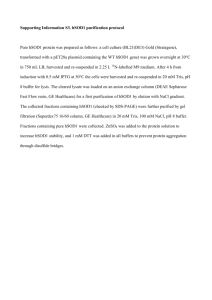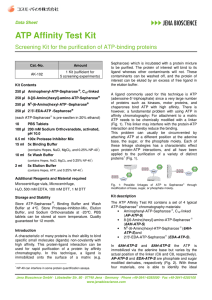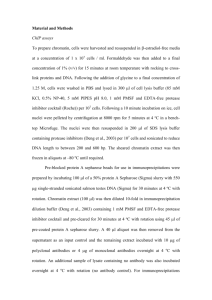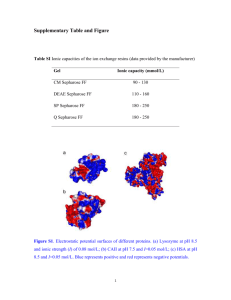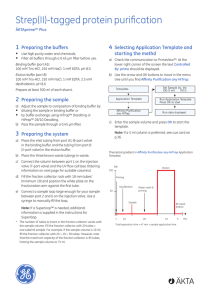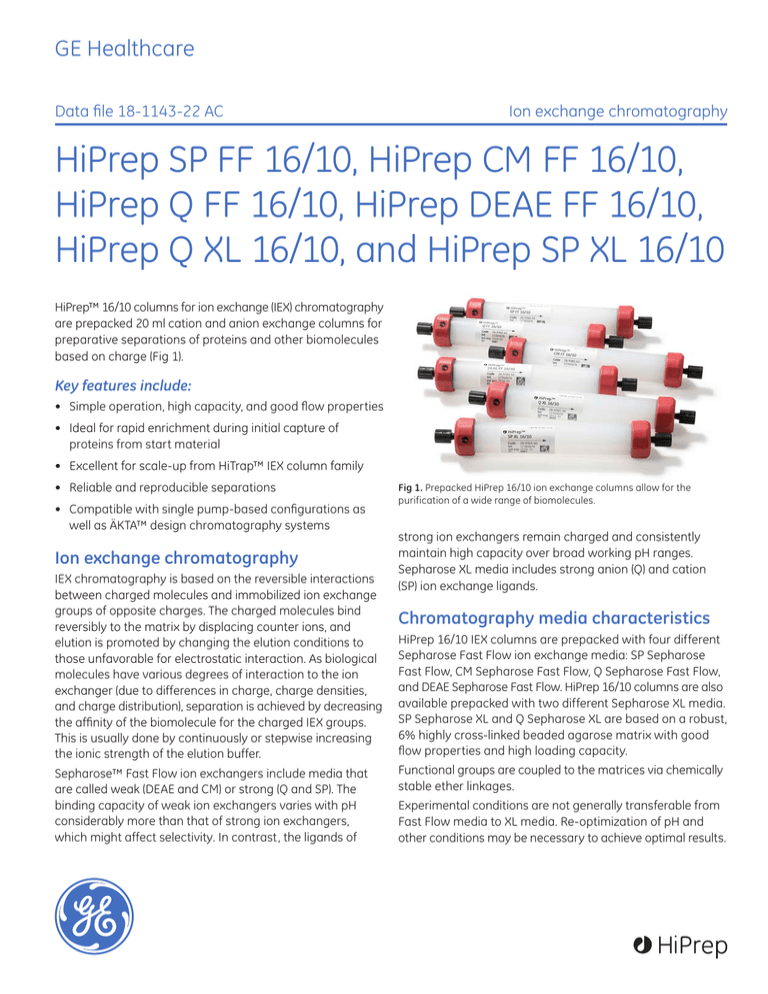
GE Healthcare
Data file 18-1143-22 AC
Ion exchange chromatography
HiPrep SP FF 16/10, HiPrep CM FF 16/10,
HiPrep Q FF 16/10, HiPrep DEAE FF 16/10,
HiPrep Q XL 16/10, and HiPrep SP XL 16/10
HiPrep™ 16/10 columns for ion exchange (IEX) chromatography
are prepacked 20 ml cation and anion exchange columns for
preparative separations of proteins and other biomolecules
based on charge (Fig 1).
Key features include:
• Simple operation, high capacity, and good flow properties
• Ideal for rapid enrichment during initial capture of
proteins from start material
• Excellent for scale-up from HiTrap™ IEX column family
• Reliable and reproducible separations
• Compatible with single pump-based configurations as
well as ÄKTA™ design chromatography systems
Ion exchange chromatography
IEX chromatography is based on the reversible interactions
between charged molecules and immobilized ion exchange
groups of opposite charges. The charged molecules bind
reversibly to the matrix by displacing counter ions, and
elution is promoted by changing the elution conditions to
those unfavorable for electrostatic interaction. As biological
molecules have various degrees of interaction to the ion
exchanger (due to differences in charge, charge densities,
and charge distribution), separation is achieved by decreasing
the affinity of the biomolecule for the charged IEX groups.
This is usually done by continuously or stepwise increasing
the ionic strength of the elution buffer.
Sepharose™ Fast Flow ion exchangers include media that
are called weak (DEAE and CM) or strong (Q and SP). The
binding capacity of weak ion exchangers varies with pH
considerably more than that of strong ion exchangers,
which might affect selectivity. In contrast, the ligands of
imagination at work
Fig 1. Prepacked HiPrep 16/10 ion exchange columns allow for the
purification of a wide range of biomolecules.
strong ion exchangers remain charged and consistently
maintain high capacity over broad working pH ranges.
Sepharose XL media includes strong anion (Q) and cation
(SP) ion exchange ligands.
Chromatography media characteristics
HiPrep 16/10 IEX columns are prepacked with four different
Sepharose Fast Flow ion exchange media: SP Sepharose
Fast Flow, CM Sepharose Fast Flow, Q Sepharose Fast Flow,
and DEAE Sepharose Fast Flow. HiPrep 16/10 columns are also
available prepacked with two different Sepharose XL media.
SP Sepharose XL and Q Sepharose XL are based on a robust,
6% highly cross-linked beaded agarose matrix with good
flow properties and high loading capacity.
Functional groups are coupled to the matrices via chemically
stable ether linkages.
Experimental conditions are not generally transferable from
Fast Flow media to XL media. Re-optimization of pH and
other conditions may be necessary to achieve optimal results.
Sepharose Fast Flow and Sepharose XL ion exchangers
are a preferred choice for separation early in purification
schemes. Full technical and regulatory support for
production-scale applications is available. The main
characteristics of HiPrep 16/10 ion exchangers are shown
in Table 1.
Table 1. Characteristics of HiPrep 16/10 ion exchangers
Cation exchangers
HiPrep SP FF 16/10
HiPrep CM FF 16/10
HiPrep SP XL 16/10
Matrix
6% highly cross-linked agarose
6% highly cross-linked agarose
Dextran attached to 6% highly
cross-linked, spherical agarose
Average particle size
90 μm
90 μm
90 µm
Type of medium
Strong cation
Charged group
Weak cation
Strong cation
-CH2-CH2-CH2SO3
-O-CH2COO
–SO3–
Total ionic capacity
0.18–0.25 mmol H+/ml medium
0.09–0.13 mmol H+/ml medium
0.18–0.25 mmol H+/ml medium
Dynamic binding capacity1
70 mg ribonuclease A/ml medium 50 mg ribonuclease A/ml medium > 160 mg lysozyme/ml medium
-
-
pH stability
Short term2
Long term3
3–14
4–13
2–14
4–13
4–13
3–14
Storage
4°C to 30°C in 20% ethanol,
0.2 M sodium acetate
4°C to 30°C in 20% ethanol
4°C to 30°C in 20 % ethanol,
0.2 M sodium acetate
Chemical stability
All commonly used buffers, 1 M NaOH, 8 M urea, 6 M guanidine
hydrochloride, and 70% ethanol
Avoid
Oxidizing agents, cationic detergents, and buffers
All commonly used buffers,
non-ionic detergents, 1 M NaOH,
6 M guanidine hydrochloride
Anion exchangers
HiPrep Q FF 16/10
HiPrep DEAE FF 16/10
HiPrep Q XL 16/10
Matrix
6% highly cross-linked agarose
6% highly cross-linked agarose
Dextran attached to 6% highly
cross-linked, spherical agarose
Average particle size
90 μm
90 μm
90 µm
Type of medium
Strong anion
Weak anion
Strong anion
Charged group
-N+(CH3)3
-N+(C2H5)2H
–N+(CH3)3
Total ionic capacity
0.18–0.25 mmol Cl-/ml medium
0.11–0.16 mmol Cl-/ml medium
0.18–0.26 mmol Cl-/ml medium
120 mg HSA/ml medium
110 mg HSA/ml medium
> 130 mg BSA/ml medium
1–14
2–12
1–14
2–12
3–13
2–14
Storage
4°C to 30°C in 20% ethanol
4°C to 30°C in 20% ethanol
4°C to 30°C in 20% ethanol
Chemical stability
All commonly used buffers, 1 M NaOH, 8 M urea, 6 M guanidine
hydrochloride, and 70% ethanol
Avoid
Oxidizing agents, anionic detergents, and buffers
Dynamic binding capacity
1
pH stability
Short term2
Long term3
1
All commonly used buffers, nonionic detergents, 1 M NaOH, 6 M
guanidine hydrochloride
Determination of dynamic binding capacity:
DEAE Sepharose Fast Flow, Q Sepharose Fast Flow, SP Sepharose Fast Flow, and CM Sepharose Fast Flow: Samples were applied at 75 cm/h until 50% breakthrough.
Columns: 0.5 × 5 cm. Buffers: 0.05 M Tris, 2 M NaCl (in the elution buffer), pH 7.5 (Q and DEAE) or 0.1 M acetate, 2 M NaCl (in the elution buffer), pH 5.0 (SP and CM).
Q Sepharose XL and SP Sepharose XL: Samples were applied at 300 cm/h until 10% breakthrough.
Column: 0.75 × 10 cm. Buffers: 0.05 M Tris, (+0.5 M NaCl in the elution buffer), pH 7.5 (Q); 0.05 M glycine (+0.5 M NaCl in the elution buffer), pH 9.0 (SP).
2
Refers to the pH interval for regeneration and cleaning.
3
Refers to the pH interval where the medium is stable over a long period of time without adverse effects on its subsequent chromatographic performance.
2
18-1143-22 AC
Column characteristics
HiPrep 16/10 columns are made of polypropylene, which
does not interact with biomolecules. HiPrep 16/10 column
characteristics are shown in Table 2. Note, HiPrep columns
are not designed to be opened or repacked.
2. Scaling up using different prepacked
Q Sepharose Fast Flow columns
Ease of scale-up is a key benefit of working with any
Sepharose Fast Flow ion exchanger. In Figure 3, a purification
is scaled up first five-fold and then twenty-fold on prepacked
HiTrap Q FF and HiPrep Q FF 16/10 columns, respectively.
Table 2. Characteristics of HiPrep 16/10 column
Column volume
20 ml
Column dimensions
1.6 × 10 cm
Recommended flow rate1
2–10 ml/min (60–300 cm/h)
Maximum flow rate1
10 ml/min (300 cm/h)
Maximum pressure over the
packed bed during operation
1.5 bar (0.15 MPa, 22 psi)
Column hardware pressure limit
5 bar (0.5 MPa, 73 psi)
Water at room temperature.
1
Applications
Columns:
Sample:
Sample volume:
Start buffer:
Elution buffer:
Gradient:
Flow rate:
Detection: System:
A
A)
1. High reproducibility
A) HiTrap Q FF 1 ml, B) HiTrap Q FF 5 ml, C) HiPrep Q FF 16/10 (20 ml)
1. Conalbumin, 2 mg/ml
2. α-lactalbumin, 4 mg/ml
3. Soy trypsin inhibitor, 6 mg/ml
1 CV (column volume) A) 1 ml, B) 5 ml, and C) 20 ml
50 mM Tris-HCl, pH 7.3
50 mM Tris-HCl, 0.5 M NaCl, pH 7.3
0% to 100% elution buffer in 20 CV
A) 20 ml, B) 100 ml, and C) 400 ml
A) 1 ml/min (150 cm/h) and B-C) 5 ml/min (150 cm/h)
280 nm
ÄKTAexplorer
2
mAU
HiTrap Q FF 1 ml
15.0
3
Figure 2 shows two purifications of GFP-(histidine)6 using
HiPrep Q FF 16/10. As shown in the figure, the replicates
gave excellent reproducibility. Absorbance at 490 nm is the
specific wavelength for the target protein, GFP.
10.0
1
5.0
0.0
Column: Sample: Sample volume: Start buffer: Elution buffer: Gradient: Flow rate: System: HiPrep Q FF 16/10
E. coli lysate with expressed GFP-(histidine)6
60 ml
50 mM Tris, pH 8.0
50 mM Tris, 1 M NaCl, pH 8.0
0% to 100% elution buffer in 10 CV
5 ml/min (150 cm/h)
ÄKTAexplorer™ 100
0
B)
B
10
15
20
25
30
ml
2
mAU
HiTrap Q FF 5 ml
20.0
3
15.0
A490 nm
mAU
A280 nm
mAU
5
1
10.0
3000
3000
2500
2500
2000
2000
50
0.0
0
1500
1500
1000
1000
25.0
500
500
20.0
C)
C
0
0
0
100
200
300
400
500
ml
Fig 2. Repetitive purifications of GFP-(histidine)6 using HiPrep Q FF 16/10
show high reproducibility (A280nm = dark blue and purple curves;
A490nm = turquoise curve).
20
40
60
80
100
120
140 ml
2
mAU
HiPrep Q FF 16/10 (20 ml)*
3
15.0
1
10.0
5.0
0.0
0
100
200
300
400
500 ml
Fig 3. Scale-up from HiTrap columns to HiPrep Q FF 16/10.
A) HiTrap Q FF 1 ml (0.7 × 2.5 cm), B) HiTrap Q FF 5 ml (1.6 × 2.5 cm), and
C) HiPrep Q FF 16/10 20 ml (1.6 × 10 cm).
* Note: Data was obtained using first-generation HiPrep 16/10 columns.
18-1143-22 AC
3
3. Effect of pH on the separation of standard
proteins on HiPrep CM FF 16/10
Column:
Sample:
Buffer:
Gradient:
HiPrep CM FF 16/10 (20 ml)*
10 mg apotransferrin, ribonuclease A, and cytochrome C in 1 ml
CIEX pH 3–7.5 BufferPrep recipe in ÄKTAexplorer
0% to 50% elution buffer in 300 ml (15 CV),
where 50% elution buffer = 0.5 M NaCl
10 ml/min (300 cm/h)
280 nm
ÄKTAexplorer
Flow rate:
Detection: System:
* Note: Data was obtained using first-generation HiPrep 16/10 columns.
A)
Choice of buffer
To avoid local disturbances in pH caused by buffering ions
participating in the ion exchange process, select an eluent
with buffering ions of the same charge as the substituent
groups on the ion exchanger. Figures 5 and 6 show a
selection of standard aqueous buffers, and Table 3 lists the
pH ranges of some volatile buffer systems.
pH
4.5
5
6
7
8
9
10
pKa
(25°C)
11
N-methyl piperazine
4.75
Piperazine
mAU
pH 5.0
5.68
bis-Tris
100%
Elution
buffer
6.46
bis-Tris propane
Triethanolamine
6.80
Tris
8.06
8.52
7.76
N-methyldiethanolamine
200
1.3-diaminopropane
8.64
9.50
Ethanolamine
Piperazine
9.73
1.3-diaminopropane 10.47
11.12
Piperidine
50
100
Fig 5. Recommended buffers for anion exchange chromatography.
pH
2.5
0
B)
3
0
0
mAU
200
4
5
6
7
8
9
Citric acid
ml
Lactic acid
pH 6.5
3.81
Butanedioic acid
4.21
Acetic acid
4.76
100%
Elution
buffer
Malonic acid
5.68
MES
6.15
Phosphate
200
50
pKa
(25°C)
3.13
7.20
HEPES
7.55
BICINE
8.35
Fig 6. Recommended buffers for cation exchange chromatography.
100
Table 3. Volatile buffer systems
0
0
0
C
mA U
200
ml
pH 7.5
100%
Elution
buffer
200
50
pH
Substances
2.3–3.5
Pyridine/formic acid
3.0–5.0
Trimethylamine/formic acid
4.0–6.0
Trimethylamine/acetic acid
6.8–8.8
Trimethylamine/HCl
7.0–8.5
Ammonia/formic acid
8.5–10.0
Ammonia/acetic acid
7.0–12.0
Trimethylamine/CO2
8.0–9.5
Ammonium carbonate/ammonia
8.5–10.5
Ethanolamine/HCl
100
Storage
0
0
0
200
ml
Fig 4. Separations of standard proteins on HiPrep CM FF 16/10 at A) pH 5.0,
B) pH 6.5, and C) pH 7.5. In this case, pH 7.5 gave the most distinct separation.
HiPrep CM FF 16/10, HiPrep Q FF 16/10, HiPrep DEAE FF 16/10,
and HiPrep Q XL 16/10 should be stored in 20% ethanol.
HiPrep SP FF 16/10 and HiPrep SP XL 16/10 should be stored
in 20% ethanol with 0.2 M sodium acetate.
The recommended storage temperature is 4°C to 30°C.
4
18-1143-22 AC
Ordering information
Products
Quantity
Code No.
HiPrep CM FF 16/10
1 × 20 ml
28-9365-42
HiPrep SP FF 16/10
1 × 20 ml
28-9365-44
HiPrep DEAE FF 16/10
1 × 20 ml
28-9365-41
HiPrep Q FF 16/10
1 × 20 ml
28-9365-43
HiPrep Q XL 16/10
1 × 20 ml
28-9365-38 HiPrep SP XL 16/10
1 × 20 ml
28-9365-40 Related products
Quantity
Code No.
HiTrap IEX Selection Kit
7 × 1 ml
17-6002-33
HiTrap Q FF
5 × 1 ml
5 × 5 ml
17-5053-01
17-5156-01
HiTrap SP FF
5 × 1 ml
5 × 5 ml
17-5054-01
17-5157-01
HiTrap DEAE FF
5 × 1 ml
5 × 5 ml
17-5055-01
17-5154-01
HiTrap CM FF
5 × 1 ml
5 × 5 ml
17-5056-01
17-5155-01
HiTrap Q XL
5 × 1 ml
5 × 5 ml
17-5158-01
17-5159-01
HiTrap SP XL
5 × 1 ml
5 × 5 ml
17-5160-01
17-5161-01
Q Sepharose Fast Flow
25 ml
300 ml†
17-0510-10
17-1510-01
SP Sepharose Fast Flow
25 ml
300 ml†
17-0729-10
17-0729-01
DEAE Sepharose Fast Flow
25 ml
500 ml†
17-0709-10
17-0709-01
CM Sepharose Fast Flow
25 ml
500 ml†
17-0719-10
17-0719-01
Q Sepharose XL
300 ml
17-5072-01
SP Sepharose XL
300 ml
17-5073-01
Q Sepharose XL virus licensed
25 ml
300 ml
17-5437-10
17-5437-01
HiTrap Desalting
5 × 5 ml
17-1408-01
HiPrep 26/10 Desalting
1 × 53 ml
17-5087-01
4 × 53 ml
17-5087-02
Accessories
Quantity
Code No.
HiTrap/HiPrep 1/16” male connector
for ÄKTA design
8
28-4010-81
Union M6 female 1/16” male
5
18-3858-01
Related literature Code No.
Ion Exchange Chromatography and Chromatofocusing:
Principles and Methods, Handbook
11-0004-21
Ion Exchange Columns and Media, Selection Guide
18-1127-31
Prepacked chromatography columns for
ÄKTA design systems, Selection guide
28-9317-78
†
Process-scale quantities are available. Please contact your local GE Healthcare representative.
18-1143-22 AC
5
GE, imagination at work and GE Monogram are trademarks of General Electric Company.
For local office contact information, visit
www.gelifesciences.com/contact
www.gelifesciences.com/protein-purification
www.gelifesciences.com/purification-techsupport
ÄKTA, ÄKTAexplorer, Drop Design, HiPrep, HiTrap, and Sepharose are trademarks of
GE Healthcare companies.
Separating viral particles with Q Sepharose XL products may require a license under US patent
6,537,793 B2 and equivalent patents and patent applications in other countries owned by Centelion
SAS. Such a license is not included with the purchase of Q Sepharose XL but is included with the
purchase of “Q Sepharose XL virus licensed” products. With the purchase of “Q Sepharose XL virus
licensed” the customer is granted a free limited license under US patent 6,537,793 B2 and equivalent
patents and patent applications in other countries owned by Centelion SAS to separate viral particles
solely through use of the product purchased.
All third party trademarks are the property of their respective owners.
GE Healthcare Bio-Sciences AB
Björkgatan 30
751 84 Uppsala
Sweden
All goods and services are sold subject to the terms and conditions of sale of the company within
GE Healthcare which supplies them. A copy of these terms and conditions is available on request.
Contact your local GE Healthcare representative for the most current information.
© 2000–2009 General Electric Company – All rights reserved.
First published July 2000.
GE Healthcare UK Limited
Amersham Place, Little Chalfont, Buckinghamshire, HP7 9NA, UK
GE Healthcare Europe, GmbH
Munzinger Strasse 5, D-79111 Freiburg, Germany
GE Healthcare Bio-Sciences Corp.
800 Centennial Avenue, P.O. Box 1327, Piscataway, NJ 08855-1327, USA
imagination at work
GE Healthcare Bio-Sciences KK
Sanken Bldg., 3-25-1, Hyakunincho, Shinjuku-ku, Tokyo 169-0073, Japan
18-1143-22 AC 03/2009

